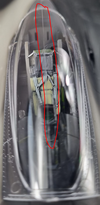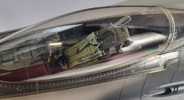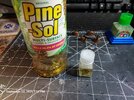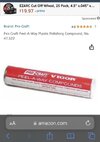Dealing with clear plastic
- Thread starter durangod
- Start date
urumomo
Well-Known Member
- Joined
- Mar 18, 2013
- Messages
- 7,754
I don't think glycolic acid , what's in that Pine-Sol multi-surface , will damage polystyrene -- but I'm not too sure with continuous submersion like that .
I'd do a long term soak on a piece of clear sprue first to establish that .
It definitely won't react with polypropylene or ethylene ,, but , uuuhhhhh
I'd do a long term soak on a piece of clear sprue first to establish that .
It definitely won't react with polypropylene or ethylene ,, but , uuuhhhhh
Motoretrolia
Member
- Joined
- Sep 7, 2024
- Messages
- 63
Is there a method to clean up canopies which have been painted on the bracing first? I finished a couple today and just want to clean things up a bit where my fingers touched the clear.
Last edited:
Motoretrolia
Member
- Joined
- Sep 7, 2024
- Messages
- 63
Thanks for the tip. I used a mix of Tamiya Chrome silver and Flat black. I was looking for a flat, weathered aluminum and feel it's reasonably close.To remove finger prints ?
A swab damp with soapy water ? blot dry with paper towel
What type of paint was used on the canopy frames ?
Last edited:
Edbert
Well-Known Member
- Joined
- May 16, 2024
- Messages
- 1,565
"Sanding" the clear will definitely leave scratches, but that is when the polish comes in. Not floor polish, that can be used later if desired, I mean the paste type of polish, even toothpaste makes a good polish of this type. You'll want to rub the paste with cloth, a LOT, but the scratches left by sanding will be removed eventually. Can use a cotton bugger in a Dremel type tool on low RPM but this runs the risk of ruining things, so be careful and slow if using a power-tool. If using your hands, go to town.
See this "seam" down the center of the F-16 canopy?

With time and care, the canopy is clearer than before.

See this "seam" down the center of the F-16 canopy?

With time and care, the canopy is clearer than before.

the Baron
Ich bin ja, Herr, in Deiner Macht
- Joined
- May 12, 2009
- Messages
- 2,275
What Future does, and other clear acrylic liquids, is to fill the tiny pits and scratches on the surface, and that's what gives the surface some clarity. The rough, pitted, scratched surface scatters light, while a smooth surface allows more light to pass through without refracting (oh, no! Science!)
For surfaces etched by glues, for example, you can polish the damaged area by sanding with successively finer grits, then use the clear coat.
And generally, many modelers will dip clear parts in a clear sealer, like Future or other non-modeling product, or in clear media from hobby companies. Same thing-this will tend to fill any fine pitting or scratches and make the surface clearer.
A note to check your sources, though, depending on the subject, the scale, etc. You can find plenty of photos of aircraft with windscreens and canopies that look rough or hazy, because the actual piece of plexiglass was worn and weathered. Check your sources and do what you feel is best for what you want to achieve.
Something else to keep in mind with clear styrene, generally, is that it can be more brittle than colored styrene (Chemistry!) So as others have mentioned, it can be better to use a fine razor saw to remove parts from the sprues, than to use a sprue nipper. Cut as far away as possible, sand and file carefully.
For surfaces etched by glues, for example, you can polish the damaged area by sanding with successively finer grits, then use the clear coat.
And generally, many modelers will dip clear parts in a clear sealer, like Future or other non-modeling product, or in clear media from hobby companies. Same thing-this will tend to fill any fine pitting or scratches and make the surface clearer.
A note to check your sources, though, depending on the subject, the scale, etc. You can find plenty of photos of aircraft with windscreens and canopies that look rough or hazy, because the actual piece of plexiglass was worn and weathered. Check your sources and do what you feel is best for what you want to achieve.
Something else to keep in mind with clear styrene, generally, is that it can be more brittle than colored styrene (Chemistry!) So as others have mentioned, it can be better to use a fine razor saw to remove parts from the sprues, than to use a sprue nipper. Cut as far away as possible, sand and file carefully.
the Baron
Ich bin ja, Herr, in Deiner Macht
- Joined
- May 12, 2009
- Messages
- 2,275
Yes! I've used toothpaste and a Dremel polishing wheel or drum occasionally."Sanding" the clear will definitely leave scratches, but that is when the polish comes in. Not floor polish, that can be used later if desired, I mean the paste type of polish, even toothpaste makes a good polish of this type. You'll want to rub the paste with cloth, a LOT, but the scratches left by sanding will be removed eventually. Can use a cotton bugger in a Dremel type tool on low RPM but this runs the risk of ruining things, so be careful and slow if using a power-tool. If using your hands, go to town...
I'll second the warning about using a power tool, though, too. With power behind the action, it's possible to slip and ruin your work. Care is necessary.
durangod
Well-Known Member
- Joined
- Aug 27, 2024
- Messages
- 457
durangod
Well-Known Member
- Joined
- Aug 27, 2024
- Messages
- 457
do i need course or just fine and finish if im only using it on clear plastic?
@TimM63 i know your having great luck with that product but says its for jewelry and i wanted something just for clear plastic. Probably the same stuff just diff packaging LOL but i went with tamiya polish.
@TimM63 i know your having great luck with that product but says its for jewelry and i wanted something just for clear plastic. Probably the same stuff just diff packaging LOL but i went with tamiya polish.
Last edited:
Similar threads
- Replies
- 1
- Views
- 304
- Replies
- 38
- Views
- 2K



